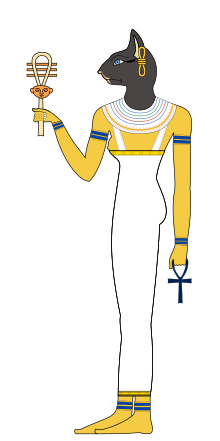
Back Bastet Afrikaans Bastet ALS باستت Arabic باستيت ARZ বাষ্টেট Assamese Bastet Azerbaijani Баст Byelorussian Баст BE-X-OLD Бастет Bulgarian Bastet Breton
| Bastet | ||||
|---|---|---|---|---|
 | ||||
| Name in hieroglyphs |
| |||
| Major cult center | Bubastis | |||
| Symbol | lioness, cat, ointment jar, sistrum, solar disk | |||
| Personal information | ||||
| Parents | Ra and Isis | |||
| Siblings | Horus and Anhur (half-brothers) | |||
| Consort | Ptah (in some myths) | |||
| Offspring | Maahes | |||
Bastet or Bast (Ancient Egyptian: bꜣstjt, Coptic: Ⲟⲩⲃⲁⲥⲧⲉ, romanized: Oubaste[2] /ʔuːˈβastə/, Phoenician: 𐤀𐤁𐤎𐤕,[3] romanized: ’bst, or 𐤁𐤎𐤕,[4] romanized: bst) is a goddess of ancient Egyptian religion, worshipped as early as the Second Dynasty (2890 BC). Her name also is rendered as B'sst, Baast, Ubaste, and Baset.[5] In ancient Greek religion, she was known as Ailuros (Koinē Greek: αἴλουρος, lit. 'cat').
Bastet was worshipped in Bubastis in Lower Egypt, originally as a lioness goddess, a role shared by other deities such as Sekhmet. Eventually Bastet and Sekhmet were characterized as two aspects of the same goddess, with Sekhmet representing the powerful warrior and protector aspect, and Bastet, who increasingly was depicted as a cat, representing a gentler aspect.[6]
- ^ Hart, George (2005). The Routledge Dictionary of Egyptian Gods and Goddesses, Second Edition, p. 45
- ^ "Coptic Dictionary Online". corpling.uis.georgetown.edu.
- ^ KAI 17, 37, 49 (34), 49 (37); CIS I 1988; RÉS 367
- ^ CIS I 1988, 2082
- ^ Badawi, Cherine. Footprint Egypt. Footprint Travel Guides, 2004.
- ^ Serpell, "Domestication and History of the Cat", p. 184.